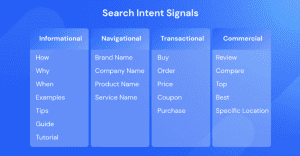
When it comes to ranking on Google and getting your site seen there are so many things that play a part. But one area often missed is writing your content, and how searcher intent can alter this.
Before you write your content, it’s first important to understand what searcher intent is, to understand how you can utilise it.
What is search intent?
To put it simply, searcher intent is understanding the type of content Google serves in a search result. Understanding and creating content with search intent in mind is very important in regards to ranking on Google.
Introduction
Getting your site seen is one of the most important parts of owning a website and with 90% of searches starting with a search engine, Google being the most popular, it’s important to understand what’s needed to be found. After all, this could determine whether your website is successful or not.
There are many ways to rank on Google, for example, it’s beneficial to write optimised content. But before you start writing content, there are a few things to keep in mind. The first is to know the searches you want your website to show for. Once you know this, it is important to then understand the searcher intent from the search results.
This will give you direction on the type of content people expect to find when performing your target search, so you can base your content around the search intent of your users.
This article will highlight the varying search intent types, and how you can utilise these to write optimised content.
A more in-depth look into Search intent
Before we look into the different search intent types, it’s important to first understand what it is.
Search intent is a simple concept. Simply put, search intent is the purpose behind a search. This refers to the reasoning behind every individual search and how this is relevant to a website, or page you’re trying to rank. A study defined it as ‘the main goal a user has when typing a query into a search engine’.
The users search intent will determine what sort of results will show on Google. The results will have a relevance to the users goal. As an example, if someone is searching for a ‘computer desk’, the goal is to purchase, and therefore the results will show desks that can be purchased, or transactional e-commerce websites. Whereas, if someone searches ‘best computer desks’, it is a more informational search, where blogs, reviews and comparisons of different computer desks might be more prevalent, so trying to get a product to sell a desk won’t be the right sort of page to show.
Understanding the intent of the searcher is important to have your website showing what people expect to find and what Google (or other search engines) will want to show.
Thankfully, ‘99% of all search terms fall under 4 different intent categories: informational, navigational, commercial and transactional’. With this narrowed down, it should be easier to understand the relevance of your pages / website regarding search intent and allow you to optimise and create content that will serve the needs of the searcher, helping you better optimise your website to be found.
Navigational
When a user searches for a website/page, then this is a navigational search. It’s likely this user already knows what they want and where they can get it from. The goal of their search is straightforward.
Navigational search results would show the specific websites searched for as well as similar alternatives, reviews and depending on the website (i.e. Netflix, Amazon), news articles, and blogs about said site.
Searches that fall under Navigational include:
- Amazon
- Nike
- Online courses Skillshare
- Gmail login
Where you can start: These searches will normally be people looking for a specific website or brand, there isn’t much that can be done to get your content to show for these kinds of results as the search does not relate to you.
Informational
As the title suggests, the user is looking for information about a topic. With so much information and answers on Google it’s no wonder this is one of the top search types. Informational results will show up if users search for a question. This could be something such as ‘when was World War 1?’ or ‘sponge cake recipe’.
The results for informational searches would show things such as blogs, YouTube videos, sites like Wikipedia and people also asked boxes.
Searches that fall under Informational include:
- How to get to London Euston
- Who is David Bowie?
- The queen
- How to cook spaghetti
Where you can start: Look at the search results, see what they are saying and what is important and think about what you can do to provide more and better information to a searcher.
Commercial
When a user is researching something and needs more information on the market, this is a commercial search. For example, if you want to buy a computer you might search ‘best laptops 2022’, a commercial search is often done before a transactional search because the customer is still considering what it is they want.
The results of a commercial search would usually show things such as reviews, blogs with lists, YouTube videos and rating sites.
Searches that fall under Commercial include:
- Best desktop computers
- Amazon Prime reviews
- Adaptive vs responsive websites?
- Top 10 headphones
Where you can start: Look at the search results, see what sort of content is there, is it listicles, comparisons and base your content strategy around this.
Transactional
These searches are done when a user wants to buy something. The purpose might be to purchase a new pair of glasses. These users will know what they want and so the goal is clear-cut.
The results of a transactional search will often show websites that have the specific product searched for, as well as shopping ads at the top of the page.
Searches that fall under Transactional searches include:
- MacBook Pro
- iPhone 13 cheap
- Sony headphones
Where you can start: Make sure that the product or service page is on the website and optimised. Avoid using things that have been copied such as manufacturer descriptions.
How to implement search intent in your keywords and content.
Now you know what Search intent is, let’s learn how to implement it using your keywords and content.
Try searching for different terms similar to your website or product. If your store sells bikes, try using different search terms to figure out which results hold the most relevance to you. Below is an image of different words one might use within these searches and where they might appear in the different search intent types.
Image from – https://www.similarweb.com/corp/blog/marketing/seo/search-intent/

It is absolutely crucial that you create and optimise your content based on the searcher’s intent. You first need to know what your users might search for and how this is relevant to your website or page. First, what’s the user looking for? Using the example above, let’s say you are trying to sell some bikes. We recommend you come up with searches that cover the whole spectrum of content people are looking for; do a few searches using the words and intent signals above to determine what sort of content you need to create and optimise.
For example, ‘top 10 bikes’ or ‘bikes Shropshire’ (or whichever location you intend to sell). From this you should be able to tell what sort of content is appearing. If when searching for the top 10 bikes a load of listed blogs appear, it may be worth considering how you could satisfy the user intent and then what sort of content you would need on your site (in this example, it would be a blog page).
If you are struggling to write content at all, this guide offers a few quick tips and solutions.
Final thoughts
Search intent plays a significant part when it comes to SEO and where you rank on Google. It helps you to optimise your website and keywords so that your users can get the most out of your website. Knowing what your users search for and the method behind that can be a massive benefit.




